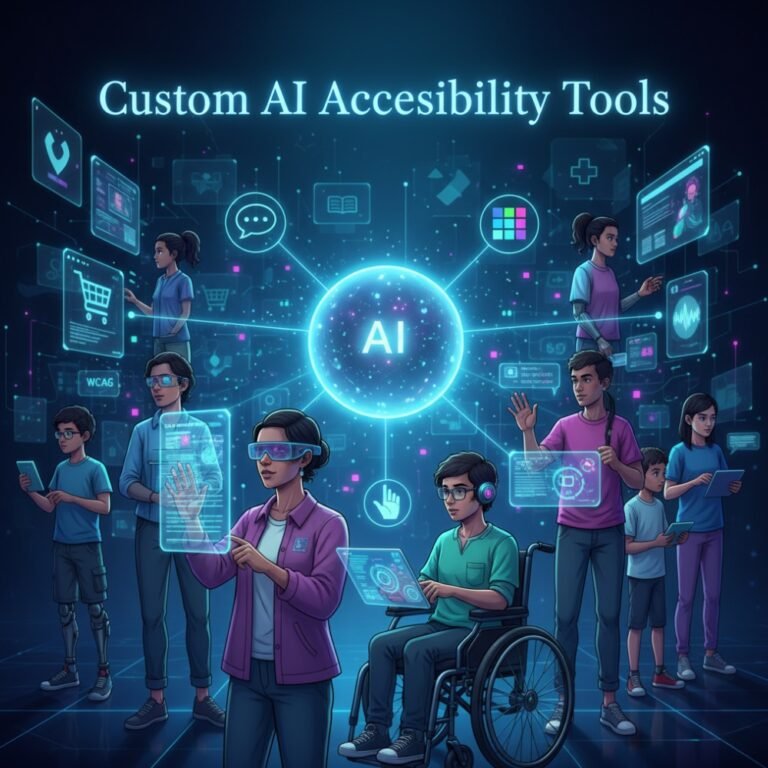Imagine this: you’re knee-deep in a web project, staring at a screen full of tangled CSS rules. Flexbox here, media queries there, and somehow, your button looks perfect on desktop but warps into a pixelated nightmare on mobile. Sound familiar? If you’re a developer, it probably does. We’ve all been there—hours lost to tweaking shadows, aligning grids, and praying for cross-browser harmony.
But what if I told you that era is ending? Enter AI styling tools, the game-changers that promise to automate the drudgery of CSS, letting autonomous AI web developers handle the heavy lifting. In 2025, these intelligent platforms aren’t just helpers; they’re revolutionising how we build beautiful, responsive sites. No more “CSS fatigue”—just smart, speedy design that scales effortlessly.
In this article, we’ll dive deep into why manual CSS is on its last legs, explore the magic of AI styling tools, and peek into a future where developers guide AI rather than wrestle code. Whether you’re a solo freelancer or part of a bustling agency, stick around—you’ll finish with actionable insights to supercharge your workflow.
The Context: Why Developers Rely on CSS—and How AI Is Upending It
CSS, or Cascading Style Sheets, has been the backbone of web styling since the late 90s. It’s what turns bland HTML skeletons into vibrant, user-friendly interfaces. Developers use it to control layouts, colours, fonts, and animations—essentially, everything that makes a site visually appealing and functional.
Think about it: without CSS, the web would be a sea of default black text on white backgrounds. But as sites grew more complex, so did CSS. Enter responsive design, where one stylesheet must adapt to desktops, tablets, and phones. Add in accessibility standards, performance tweaks, and the endless chase for pixel-perfect renders, and you’ve got a recipe for overwhelm.
Now, AI is flipping the script. Autonomous AI web developers—tools that generate code independently based on natural language prompts or design inputs—are making CSS feel archaic. Instead of hand-coding every rule, you describe what you want (“a sleek navbar that glows on hover”), and AI spits out optimised code. It’s like having a tireless junior dev who never sleeps, learns from vast datasets, and iterates in seconds.
This shift isn’t hype; it’s necessity. With web traffic exploding on mobile (over 60% globally in 2025), manual methods can’t keep up. AI styling tools bridge the gap, empowering even non-experts to create pro-level designs. But to appreciate the revolution, let’s first unpack the pains of doing it the old way.
The Problem with Manual CSS
Manual CSS writing is like painting a mural with a toothpick—precise, but painfully slow. In today’s fast-paced dev world, where deadlines loom and users demand flawless experiences, these struggles are all too real.
Common Struggles: Cross-Browser Quirks, Responsiveness, and Bloated Codebases
Ever spent a Friday afternoon fixing how your layout renders in Safari versus Chrome? Cross-browser compatibility is a nightmare. What works flawlessly in one engine might shift elements by a few pixels in another, thanks to subtle differences in how browsers interpret CSS specs.
Responsiveness adds another layer. Media queries let you adjust styles for screen sizes, but crafting them requires constant testing across devices. Miss one breakpoint, and your site looks squished on a foldable phone. Large codebases exacerbate this—projects balloon to thousands of lines, making maintenance a hunt for needles in haystacks.
Time-Consuming Styling Versus Lightning-Fast Prototyping
Styling eats time. A simple landing page might take days of iteration: tweaking margins, balancing whitespace, ensuring contrast ratios meet WCAG guidelines. Meanwhile, prototyping tools let you mock up ideas in minutes, but bridging to production CSS? That’s where the bottleneck hits.
Consider a mid-sized e-commerce site. Manual CSS could clock 40+ hours just for responsive tweaks. In contrast, fast prototyping with no-code tools teases out user feedback early, but without AI, translating those to clean code is manual labour.
A Real Example of CSS Fatigue in Modern Development
Take Sarah, a front-end dev at a London startup. Her team was building a dashboard app. Weeks in, CSS issues piled up: buttons misaligned on high-DPI screens, dark mode toggles breaking in Edge, and a 200KB stylesheet slowing load times. “I was drowning in specificity wars,” she recalls. Burnout hit, velocity dropped, and the launch slipped by two weeks. Stories like Sarah’s are epidemic—surveys show 70% of devs cite styling as their top frustration.
It’s clear: manual CSS is holding us back. Time for a better way.
What Are AI Styling Tools?
At their core, AI styling tools are intelligent software that automates CSS generation using machine learning. They analyse design inputs—sketches, prompts, or even Figma files—and output production-ready stylesheets. No more guessing selectors; AI handles the logic, from grid systems to hover effects.
Unlike static code editors, these tools learn from millions of design patterns, predicting what “modern and minimalist” looks like before you specify.
How They Differ from Traditional Frameworks Like Bootstrap or Tailwind
Frameworks like Bootstrap offer pre-built components—think ready-made buttons and navbars. Tailwind takes a utility-first approach, letting you compose styles with classes like bg-blue-500. They’re brilliant for speed but rigid: Bootstrap’s heft can bloat sites, and Tailwind demands memorising classes.
AI tools? They’re dynamic. They generate bespoke CSS tailored to your needs, not off-the-shelf kits. Want a gradient that shifts based on user scroll? AI crafts it uniquely, without framework constraints. Plus, they evolve—feed in feedback, and they refine.
Integration with Design-to-Code AI Platforms
Seamless handoffs are key. Tools like Figma-to-CSS automation (think Locofy.ai) pull wireframes directly into code. Upload a mockup, and AI extracts colours, spacings, and animations as CSS variables. This closes the designer-dev loop, making autonomous AI web developers a reality—code writes itself from visuals.
In short, AI styling tools aren’t replacements; they’re accelerators, turning vague ideas into polished code.
Core Features of AI Styling Tools
What makes these tools tick? Let’s break down the must-haves that set them apart.
Auto-Generation of Responsive Layouts
Forget manual media queries. AI scans your design and generates fluid grids using CSS Grid or Flexbox. It anticipates breakpoints—e.g., stacking cards at 768px—and tests virtually across devices. Result? A layout that breathes on any screen.
Adaptive Colour Palettes and Typography
AI doesn’t just pick colours; it builds palettes that harmonise. Input “vibrant yet professional,” and it suggests schemes with accessible contrasts (AA-compliant out of the box). For typography, it scales fonts responsively, ensuring readability from 320px mobiles to 4K monitors.
AI-Driven Theme Customisation
Themes on steroids. Switch from light to dark mode? AI propagates changes across your site, adjusting shadows and borders intelligently. Customise with prompts: “Make it cyberpunk”—watch neon accents emerge.
Smart Code Optimisation (Removing Unused CSS)
Bloat be gone. AI purges dead code, minifies rules, and even suggests CSS custom properties for reusability. A 50KB stylesheet shrinks to 10KB, boosting load speeds without sacrificing style.
These features aren’t gimmicks; they’re daily lifesavers for devs chasing efficiency.
Benefits of AI Styling Tools Over Manual CSS
Why switch? The gains are tangible, from desk to bottom line.
Speed and Efficiency
Manual CSS: 5-10 hours per page. AI: Minutes. Tools like these slash prototyping time by 80%, per industry benchmarks. That means more features shipped, faster.
Consistency Across Devices
AI enforces uniformity. No more “it works on my machine” excuses—generated code is battle-tested, ensuring your hero image scales flawlessly from iPhone to iPad.
Reduced Need for Expert-Level CSS Knowledge
Junior devs thrive. AI democratises design, so you focus on logic, not lore. Even non-coders can prompt their way to pro results, empowering solo autonomous AI web developers.
Real-World Productivity Boost (Hours Saved)
Picture a freelance project: Manual might take 20 hours styling a multi-page site. With AI, it’s 4-5. Agencies report 3x velocity; one study found teams saving 200+ hours quarterly on styling alone. That’s time for innovation, not iteration.
In essence, AI isn’t lazy coding—it’s smart scaling.
Popular AI Styling Tools in 2025
2025’s lineup is stacked, blending startups with tech giants. Here’s a curated selection, each shining in unique ways.
v0 by Vercel: Prompt-driven UI generator. “Build a dashboard with charts”—boom, styled components ready. Deployment-friendly, with Next.js integration.
Galileo AI: A prompt-to-design wizard. Describe your UI, and it generates editable Figma prototypes with instant CSS export. Ideal for ideation—free tier for solos.
Uizard: From sketch to code in clicks. Scan a napkin drawing, and AI builds interactive prototypes with responsive CSS. Great for UX teams; integrates with React.
Locofy.ai: Figma’s best mate. Converts designs to clean HTML/CSS or frameworks like Tailwind. Lightning-fast, with lightning optimisation—perfect for agencies.
TeleportHQ: Vision-to-code powerhouse. Upload images, get pixel-perfect CSS. Its collaborative editor shines for remote teams; supports real-time previews.
Kombai: AI that extracts CSS from screenshots or PDFs. No design files? No problem. Exports to multiple frameworks; strong on enterprise-scale. GitHub Copilot for CSS: Your IDE’s secret weapon. Autocompletes styles as you type, suggesting responsive tweaks. Free with GitHub Pro; unbeatable for code-first devs.
These aren’t exhaustive, but they cover most needs—from free experiments to pro pipelines.
Comparison Table: Manual CSS vs. AI Styling Tools
| Aspect | Manual CSS | AI Styling Tools |
|---|---|---|
| Time to Style a Page | 5-20 hours | 5-30 minutes |
| Responsiveness | Manual queries; error-prone | Auto-generated; device-agnostic |
| Learning Curve | High (deep CSS knowledge needed) | Low (prompt-based) |
| Consistency | Varies by dev | Uniform across projects |
| File Size | Prone to bloat (avg. 100KB+) | Optimised (under 20KB typical) |
| Cost | Free (your time) | £10-50/month per tool |
| Creativity | Unlimited but slow | Prompt-guided; evolving with ML |
This table highlights the shift: AI trades upfront cost for massive long-term wins.
How AI Styling Tools Work Under the Hood
Curious about the brains behind the beauty? It’s machine learning magic.
Use of Machine Learning for Design Patterns
AI trains on datasets of top sites—think GitHub repos, Dribbble shots. Neural networks spot patterns: “Hero sections use 80% full-width images with overlay text.” When you prompt, it matches and generates similar, optimised CSS.
Natural Language to CSS (Prompt-Based Styling)
Powered by LLMs like GPT variants, tools parse English (or code) into rules. “Centre a card with rounded corners” becomes display: flex; justify-content: center; border-radius: 8px;. Fine-tune with specifics: “Add a subtle pulse animation.”
Real-Time Feedback Loops (Previewing Live Designs)
No blind coding. AI renders previews instantly, letting you tweak via chat: “Make the shadow softer.” It iterates, updating CSS on the fly— a loop that mimics human trial-and-error but at AI speed.
Under the bonnet, it’s transformers and diffusion models, but the output? Effortless elegance.
AI Styling Tools vs. CSS Frameworks
Are frameworks doomed? Not quite, but they’re evolving.
Why Tailwind/Bootstrap Might Become Obsolete
Tailwind’s utility classes speed things up, but they’re verbose—HTML bloats with p-4 m-2. Bootstrap’s components are dated for custom needs. AI generates semantic, lightweight code without the overhead, adapting to trends like glassmorphism on demand.
Hybrid Approach: Combining AI with Frameworks
Smart devs mix ’em. Use AI to bootstrap Tailwind configs, then refine. Tools like Locofy export directly to Tailwind, blending AI creativity with framework reliability. It’s the best of both: speed plus structure.
Challenges & Limitations of AI Styling Tools
No tool’s perfect. Here’s the fine print.
Code Bloat or Lack of Fine Control
Sometimes AI over-generates—redundant rules creep in. Fine control? Prompts help, but nuanced tweaks (e.g., sub-pixel positioning) still need manual edits.
Dependency on AI Prompts
Garbage in, garbage out. Vague inputs yield meh results; mastery takes practice. Plus, hallucinations—AI inventing non-standard CSS—can sneak through.
Potential Lack of Creativity Compared to Human Designers
AI excels at patterns but struggles with “out there” concepts. A human might invent a wavy edge effect; AI sticks to trained tropes. For now, it’s augment, not replace.
These hurdles are shrinking with better models, but expect iteration.
Case Studies & Real-World Applications
Theory’s great; results are better. Let’s look at wins.
Small Businesses Rapidly Building Websites
Take EcoThreads, a UK sustainable fashion startup. Using Uizard, their founder—a non-dev—prototyped a full e-shop in a weekend. AI handled responsive product grids; launch followed in weeks. Revenue? Up 40% from faster market entry.
Enterprise-Level Design Systems Adopting AI
At a FTSE 100 bank, TeleportHQ streamlined their design system. Teams converted 500+ Figma components to CSS in days, not months. Consistency soared; dev time halved. “AI turned chaos into a library,” says their lead designer.
Developers Using AI for Prototyping MVPs
Freelancer Alex built an MVP for a fitness app with Galileo AI. Prompted layouts, exported CSS to Vue—done in 10 hours versus 50. Client loved the polish; he landed repeat work. For autonomous AI web developers, it’s MVP magic.
These stories show AI scaling from solo gigs to corps.
The Future of Front-End Development
Peering ahead, manual CSS won’t vanish overnight, but it’ll fade.
Will Manual CSS Die Completely?
Unlikely fully—edge cases need human touch. But for 80% of styling? AI takes over. By 2030, expect 90% adoption, per forecasts.
Role of Developers: Guiding AI Instead of Writing Every Line
Devs become conductors. Prompt, review, deploy. Skills shift to AI orchestration—ethical prompting, integration, and creative oversight. Autonomous AI web developers mean more strategy, less syntax.
Predictions for Next 5–10 Years in Styling Automation
- 2026-2030: Voice-activated styling; AR previews.
- 2030+: Full-gen AI suites, self-healing styles that adapt to user behaviour.
- Hybrid humans-AI teams dominate, with CSS as a legacy skill.
Exciting times—styling becomes strategic, not slog.
SEO & Performance with AI Styling Tools
AI doesn’t just prettify; it powers up search and speed.
How AI Can Generate Lightweight, SEO-Friendly Styles
Tools embed schema-friendly classes, optimise for crawlers. Semantic CSS (e.g., auto-generated ARIA labels) boosts accessibility scores, a Google ranking factor. Plus, clean code means faster indexing.
Better Core Web Vitals Through Automated Optimisation
AI minifies, lazy-loads images via CSS, and prioritises above-fold renders. Largest Contentful Paint drops 30%; CLS errors vanish. Tools like Kombai even suggest AMP-compatible styles for mobile SEO.
In 2025, SEO-savvy AI means higher ranks with less sweat.
Frequently Asked Questions (FAQs)
What is the best AI styling tool for beginners?
Uizard or Galileo AI—both prompt-friendly and forgiving for newbies.
Can AI styling tools replace CSS frameworks entirely?
Not yet, but hybrids rule. Start with AI for generation, frameworks for structure.
How much do AI styling tools cost in 2025?
Free tiers abound (e.g., ChatGPT basics), but pro plans run £10-£50/month.
Are AI-generated CSS files editable?
Absolutely—export as standard CSS for tweaks in your editor.
Will learning CSS become obsolete with AI?
No, but focus shifts to understanding principles over rote writing.
There you have it: AI styling tools aren’t killing CSS—they’re liberating it. Ready to ditch the manual grind? Pick a tool, prompt boldly, and watch your productivity soar. What’s your first experiment? Drop a comment below.








